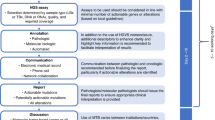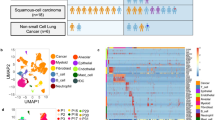Abstract
Expression of insulin-like growth factor-binding protein-3, which (IGFBP-3) inhibits the proliferation of non-small-cell lung cancer (NSCLC) cells by inducing apoptosis, is lost in about half of stage I NSCLC cases. Since promoter methylation can silence gene expression, we investigated whether hypermethylation of the IGFBP-3 promoter is involved in loss of IGFBP-3 expression in NSCLC. We found the IGFBP-3 promoter to be methylated in seven of 13 NSCLC cell lines and in 16 of 23, seven of 9, eight of 11, and six of six tumor specimens from patients with stage I, II, III, and IV NSCLC, respectively. Methylation status correlated with IGFBP-3 mRNA and protein levels in a subset of NSCLC cell lines tested in our study. However, treatment with 5′-aza-2′-deoxycytidine (5′-aza-dC) restored IGFBP-3 expression in four of seven NSCLC cell lines with the methylated promoter, suggesting that multiple mechanisms regulate IGFBP-3 expression in NSCLC. Gel shift and chromatin immunoprecipitation assays showed that methylation of the Sp-1/Sp-3-binding element in the IGFBP-3 promoter influenced the binding of Sp-1, methyl-CpG-binding protein-2 (MeCP2), and histone deacetylase (HDAC). A luciferase construct expressing IGFBP-3 promoter in which the Sp-1/Sp-3 binding element was methylated showed significantly reduced transcriptional activity. The reduction in promoter activity was further suppressed by overexpression of MeCP2, which was rescued by 5′-aza-dC. Thus interference with Sp-1 transactivation by MeCP2 may contribute to the transcriptional defect of IGFBP-3 expression in NSCLC cells with methylated promoter.
This is a preview of subscription content, access via your institution
Access options
Subscribe to this journal
Receive 50 print issues and online access
$259.00 per year
only $5.18 per issue
Buy this article
- Purchase on Springer Link
- Instant access to full article PDF
Prices may be subject to local taxes which are calculated during checkout







Similar content being viewed by others
Abbreviations
- IGFBP-3:
-
insulin-like growth factor-binding protein-3
- NSCLC:
-
non-small-cell lung cancer
- HDAC:
-
histone deacetylase
- MeCP2:
-
methyl-CpG-binding protein-2
- TRD:
-
transcription repression domain
- FCS:
-
fetal calf serum
- SDS:
-
sodium dodecyl sulfate
- ECL:
-
enhanced chemiluminescence
- GAPDH:
-
glyceraldehyde-3 phosphate dehydrogenase
- 5′-aza-dC:
-
5′-aza-2′-deoxycytidine
- PCR:
-
polymerase chain reaction
- ChIP assay:
-
chromatin immunoprecipitation assay
- MSP:
-
methylation-specific polymerase chain reaction
- MBD:
-
methyl CpG-binding domain
References
Baylin SB and Herman JG . (2000). Trends Genet., 16, 168–174.
Buckbinder L, Talbott R, Velasco-Miguel S, Takenaka I, Faha B, Seizinger BR and Kley N . (1995). Nature, 377, 646–648.
Butt AJ, Firth SM, King MA and Baxter R . (2000). J. Biol. Chem., 275, 39174–39181.
Chang YS, Kong G, Sun S, Liu D, El-Naggar AK, Khuri FR, Hong WK and Lee HY . (2002a). Clin. Cancer Res., 8, 3796–3802.
Chang YS, Wang L, Liu D, Mao L, Hong WK, Khuri FR and Lee HY . (2002b). Clin. Cancer Res., 8, 3669–3675.
Chen H, Lin RJ, Xie W, Wilpitz D and Evans R . (1999). Cell, 98, 675–686.
Choi HS, Lee JH, Park JG and Lee YI . (2002). Biochem. Biophys. Res. Commun., 296, 1005–1012.
Clark SJ, Harrison J and Molloy PL . (1997). Gene, 195, 67–71.
Cohen HT, Bossone SA, Zhu G, McDonald GA and Sukhatme VP . (1997). J. Biol. Chem., 272, 2901–2913.
Comb M and Goodman HM . (1990). Nucleic Acids Res., 18, 3882–3975.
Cubbage ML, Suwanichkul A and Powell DR . (1990). J. Biol. Chem., 265, 12642–12649.
Daskalakis M, Nguyen TT, Nguyen C, Guldberg P, Kohler G, Wijermans P, Jones PA and Lubbert M . (2002). Blood, 100, 2957–2964.
Dear C, Ma J, Wilkin F, Paquette JR, Rozen F, Ge B, Hudson T, Stampfer M and Pollak M . (2001). J. Clin. Endocrinol. Metab., 86, 1274–1280.
Fowler CA, Perks CM, Newcomb PV, Savage PB, Farndon JR and Holly JM . (2000). Int. J. Cancer, 88, 448–453.
Graessmann M and Graessmann A . (1993). EXS, 64, 404–424.
Gray SG, Kytola S, Lui WO, Larsson C and Ekstrom TJ . (2000). Int. J. Mol. Med., 5, 33–41.
Gucev ZS, Oh Y, Kelley KM and Rosenfeld RG . (1996). Cancer Res., 56, 1545–1550.
Hanafusa T, Yumoto Y, Nouso K, Nakatsukasa H, Onishi T, Fujikawa T, Taniyama M, Nakamura S, Uemura M, Takuma Y, Yumoto E, Higashi T and Tsuji T . (2002). Cancer Lett., 176, 149–158.
Herman JG, Graff JR, Myohanen S, Hamilton SR, Nelki BD and Baylin SB . (1996). Proc. Natl. Acad. Sci. USA, 93, 9821–9826.
Iguchi-Ariga SM and Schaffner W . (1989). Genes Dev., 3, 612–619.
Jones PL, Veenstra GC, Wade PA, Vermaak D, Kass SU, Landsberger N, Strouboulis J and Wolffe AP . (1998). Nat. Genet., 19, 187–191.
Kaludov NK and Wolffe AP . (2000). Nucleic Acids Res., 28, 1921–1928.
Kass SU, Pruss D and Wolffe AP . (1997). Trends Genet., 13, 444–449.
Kim SK, Ro JY, Kemp BL, Lee JS, Kwon TJ, Fong KM, Sekido Y, Minna JD, Hong WK and Mao L . (1997). Cancer Res., 57, 400–403.
Kovesdi I, Reichel R and Nevins JR . (1987). Proc. Natl. Acad. Sci. USA, 84, 2180–2184.
Kudo S . (1998). Mol. Cell. Biol., 18, 5492–5499.
Kuo MH and Allis CD . (1998). BioEssays, 20, 615–626.
Lee H-Y, Chun K-H, Liu B, Wiehle SA, Cristiano RJ, Hong WK, Cohen P and Kurie JM . (2002). Cancer Res., 62, 3530–3537.
Lee H-Y, Dawson MI, Claret F-X, Chen JD, Walsh GL, Hong WK and Kurie JM . (1997). Cell Growth Differ., 8, 283–291.
Lee H-Y, Dohi DF, Kim Y-H, Walsh GL, Consoli U, Andreef M, Dawson MI, Hong WK and Kurie JM . (1998). J. Clin. Invest., 101, 1012–1019.
Lewis JD, Meehan RR, Henzel WJ, Maurer-Fogy I, Jeppesen P, Klein F and Bird A . (1992). Cell, 69, 905–914.
Macleod D, Charlton J, Mullins J and Bird AP . (1994). Genes Dev., 8, 2282–2292.
Martin JL, Coverley JA, Pattison ST and Baxter RC . (1995). Endocrinology, 136, 1219–1226.
Meehan RR, Lewis JD, McKay S, Kleiner EL and Bird AP . (1989). Cell, 58, 499–507.
Nakao M, Matsui S, Yamamoto S, Okumura K, Shirakawa M and Fujita N . (2001). Brain Dev., 23, S174–S176.
Nan X, Campoy FJ and Bird A . (1997). Cell, 88, 471–481.
Nan X, Meehan RR and Bird A . (1993). Nucleic Acids Res., 21, 4886–4892.
Nan X, Ng HH, Johnson CA, Laherty CD, Turner BM, Eisenman RN and Bird A . (1998). Nature, 393, pp. 386–389.
Ng HH and Bird A . (1999). Curr. Opin. Genet. Dev., 9, 158–163.
Ng HH, Zhang Y, Hendrich B, Johnson CA, Turner BM, Erdjument BH, Tempst P, Reinberg D and Bird A . (1999). Nat. Genet., 23, 58–61.
Oh Y, Muller HL, Lamson G and Rosenfeld RG . (1993). J. Biol. Chem., 268, 14964–14971.
Rajah R, Valentinis B and Cohen P . (1997). J. Biol. Chem., 272, 12181–12188.
Razin A . (1998). EMBO J., 17, 4905–4908.
Samson SL-A and Wong NCW . (2002). J. Mol. Endocrinol., 29, 265–279.
Tate PH and Bird AP . (1993). Curr. Opin. Genet. Dev., 3, 226–231.
Valentinis B, Bhala A, DeAngelis T, Baserga R and Cohen P . (1995). Mol. Endocrinol., 9, 361–367.
Walker GE, Wilson EM, Powell D and Oh Y . (2001). Endocrinology, 142, 3817–3827.
Yu F, Thiesen J and Stratling WH . (2000). Nucleic Acids Res., 28, 2201–2206.
Zhang XY, Ehrlich KC, Wang RY and Ehrlich M . (1986). Nucleic Acids Res., 14, 8387–8397.
Zi X, Zhang J, Agarwal R and Pollak M . (2000). Cancer Res., 60, 5617–5620.
Acknowledgements
This work was supported by National American Cancer Society RSG-04-082-01-TBE 01 (to H-Y Lee), National Institutes of Health Grants1RO1 CA100816-01A1 (to H-Y Lee), and Department of Defense grant DAMD 17-01-1-0689 (to WK Hong) from the Department of Defense.
Author information
Authors and Affiliations
Corresponding author
Rights and permissions
About this article
Cite this article
Chang, Y., Wang, L., Suh, YA. et al. Mechanisms underlying lack of insulin-like growth factor-binding protein-3 expression in non-small-cell lung cancer. Oncogene 23, 6569–6580 (2004). https://doi.org/10.1038/sj.onc.1207882
Received:
Revised:
Accepted:
Published:
Issue Date:
DOI: https://doi.org/10.1038/sj.onc.1207882
Keywords
This article is cited by
-
Insulin-like growth factor binding protein 3 promotes radiosensitivity of oral squamous cell carcinoma cells via positive feedback on NF-κB/IL-6/ROS signaling
Journal of Experimental & Clinical Cancer Research (2021)
-
Impact of IGF-1, IGF-1R, and IGFBP-3 promoter methylation on the risk and prognosis of esophageal carcinoma
Tumor Biology (2016)
-
Epigenetic regulation of insulin-like growth factor binding protein-3 (IGFBP-3) in cancer
Journal of Cell Communication and Signaling (2015)
-
IGFBP3 impedes aggressive growth of pediatric liver cancer and is epigenetically silenced in vascular invasive and metastatic tumors
Molecular Cancer (2012)
-
Phase 1 study of ganitumab (AMG 479), a fully human monoclonal antibody against the insulin-like growth factor receptor type I (IGF1R), in Japanese patients with advanced solid tumors
Cancer Chemotherapy and Pharmacology (2012)



